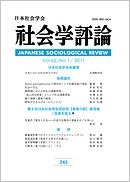All issues

Volume 36 (1985 - 198・・・
- Issue 4 Pages 406-
- Issue 3 Pages 286-
- Issue 2 Pages 148-
- Issue 1 Pages 2-
Volume 36, Issue 4
Displaying 1-7 of 7 articles from this issue
- |<
- <
- 1
- >
- >|
-
Fumie Kumagai1986Volume 36Issue 4 Pages 406-423
Published: March 31, 1986
Released on J-STAGE: December 10, 2010
JOURNAL FREE ACCESSA dual structure is a social structure which simultaneously contains elements of both modernity and tradition within itself. The uniqueness of Japanses society can be attributed to the fact that the family, one of the most fundamental institutions in society, exhibits the dual nature of both modernity and tradition.
Analyses of external and internal aspects of the Japanes family today reveal that it is not modern or traditional, but that it is a harmonious coexistence of both modernity and tradition. For example, external or demographic characteristics of the Japanese family examined in the present study all demonstrate the modern nature of the Japanese family today. The internal or structural nature of the Japanese family and household today, on the contrary, exemplifies the persistence of the traditional elements. These findings suggest that the uniqueness of the Japanese family today exists in the very fact that it is externally modern but internally traditional. This harmonious coexistence of traditional-modern nature of the Japanese family today in a certain sense parallels the history of Japan as a modern society, in that Western industrial technology was enthusiastically adopted, but at the same time traditional Japanese culture was retained. This duality is the essence of Japanese society today as well as the unique feature of the contemporary Japanese family.View full abstractDownload PDF (2441K) -
The Motivation Crisis in Modern FamilyMasahiro Yamada1986Volume 36Issue 4 Pages 424-437
Published: March 31, 1986
Released on J-STAGE: December 10, 2010
JOURNAL FREE ACCESSFamily activities in modern society differ from labour in the market sector. Illich notices family activities are non-payment labour and Boulding notices family activities are characterized by ‘gift’ instead of exchange. These characters have been maintained by exclusin of utilitarian motivation and supply of emotional and moral motivation, instead market sector have been maitained by supply of utilitarian motivation and exclution of emotional and moral motivation. This division of motivational mechanism has supported the production and reproduction of the capitalist society. The recent family situation in advanced capitalist society is shaking this division system. The character of emotional motivation is changing moral motivation become weeker and utilitarian motivation is invasing family activities. Consequently, the case that sufficient activities of family isn't supplied and that family activities execute for the market sector increase in number. The government of capitalist states have noticed this motivational crisis in the family sector, and have intervened the family activities, but not successfully. I try to examine this process, examplifing the family policy in U. S. A..View full abstractDownload PDF (1849K) -
Mariko Nohata1986Volume 36Issue 4 Pages 438-456
Published: March 31, 1986
Released on J-STAGE: December 10, 2010
JOURNAL FREE ACCESSEquality between women and men, the utilization of women's capability and their promotion are urgent problems in recent years. In this paper, the career-formation process of managerial women are analyzed.
In most studies of managerial women, the preventing factors have been investigated. On the contrary, the promoting factors are made clear in this research by the procedure of life history which regards subjective factors as important.
Firstly, the process of career-formation is explained by interrelating the subjective and objective factors, through tracing the personal history of working life from entering a company until now. At the same time, some typical patterns are classified noticing the qualitative representation.
Secondly, the characteristic factors promoting career-formation are examined. They are factors of the history, industries, companies, human relations, the movement and the consciousness.View full abstractDownload PDF (1880K) -
Kenji Akiyama1986Volume 36Issue 4 Pages 457-470
Published: March 31, 1986
Released on J-STAGE: December 10, 2010
JOURNAL FREE ACCESSIn interrelations of adjacent occupations every occupation shows clearly the possibility or the impossibility of its professionalizing. Accordingly I analyze the interrelations on medical occupations, legal ones, and so on.
Between adjacent occupations, one occupation is prevented from professionalizing by the other occupation when the job territory of the former overlaps with that of the latter, or the function of the former can be included by that of the latter. The cause of non-professionalizing is A or B.
A. The theoretical knowledges which both or either of those occupations uses are insufficiently systematic.
B. The technology of the former occupation is confined in a part of vertically divided service process while that of the latter occupation is not confined.
Therefore, by the removal of each cause, the occupations whose job territories overlap with those of their adjacent occupations, or whose functions can be included by those of their adjacent occupations professionalize to a high degree. But all the occupations can not remove each cause. Some of the occupations can remove it and others can not.View full abstractDownload PDF (2010K) -
Toru Onai1986Volume 36Issue 4 Pages 471-472
Published: March 31, 1986
Released on J-STAGE: December 10, 2010
JOURNAL FREE ACCESSDownload PDF (267K) -
[in Japanese]1986Volume 36Issue 4 Pages 473-477
Published: March 31, 1986
Released on J-STAGE: December 10, 2010
JOURNAL FREE ACCESSDownload PDF (636K) -
1986Volume 36Issue 4 Pages 489-497
Published: March 31, 1986
Released on J-STAGE: December 10, 2010
JOURNAL FREE ACCESSDownload PDF (1041K)
- |<
- <
- 1
- >
- >|